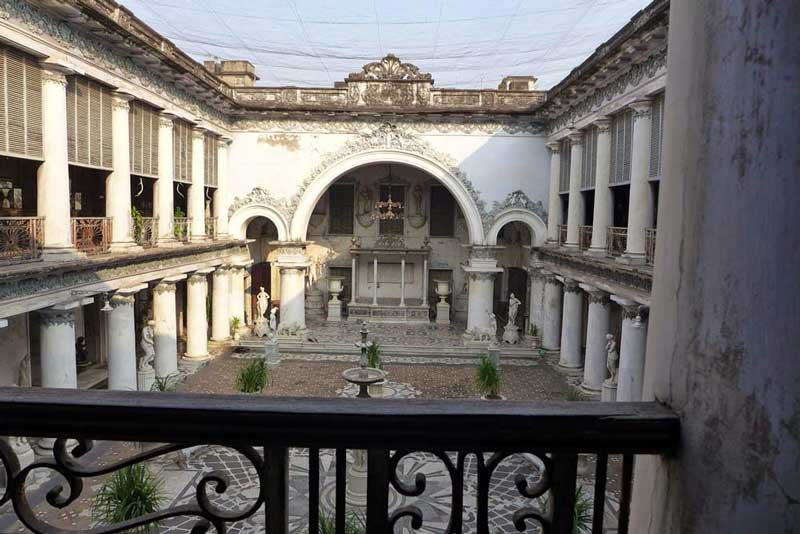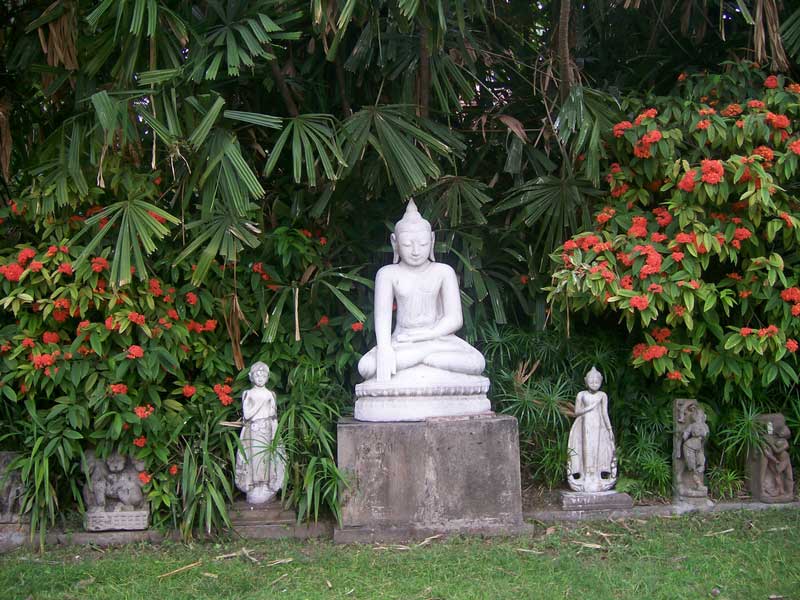
Situated at 46, Muktaram Babu Street, opposite Ram Mandir in Jorasanko area, the Marble Palace was built in 1835 by Raja Rajendra Mullick.
The history of the Mullick family of Chorbagan dates back to the earliest days of Calcutta when Babu Jayram Mullick (15th generation) first came from Hoogly or Chinsurah and settled at Gobindapur, the southern part of Calcutta. Subsequently, the area was acquired by the British Government for the construction of the Fort William and a plot of land was allotted to Jayram Mullick at Pathuriaghata for his dwellings. However, the authentic history of the family begins with Ganga Bishnu Mullick, the son of Babu Shyam Sundar Mullick, who used to reside with his brother Ramkrishna Mullick in the family dwelling-house at Pathuriaghata. Along with an extensive banking business, he was also engaged in mercantile transactions on a large scale. Babu Nilmani Mullick, the only son of Ganga Bishnu Mullick, was a man widely known for his charity and was a leading man of his time. He built a Thakurbari of Jagarnath Deb at Chorebagan and established an Atithsala or Alms House attached to it, where a large number of the poor and helpless of every caste and creed are daily served food till this day. Nilmani Mullick’s father had one brother named Ram Krishna Mullick, who had two sons. Hence, the ancestral properties were divided into three equal parts. In his early childhood, Rajendra was adopted by Nilmani Mullick. However, when Rajendra was only three, Nilmani passed away, leaving behind his fabulous wealth to be inherited by his adopted son, Rajendra. During that time, Rajendra’s widowed mother moved with him from Pathuriaghata residence to Chorbagan, where his philanthropic father had his Thakurbari or a place of worship and a permanent kitchen for feeding the poor.

During the early days of Calcutta, Chorbagan was known as a notorious area. Pilgrims carrying offerings to the Goddess Ganga used to pass through that wooded area and were often robbed by the miscreants. Hence the locality became infamous as Chorbagan, the garden of thieves. Gradually, the jungle gave way to a cosmopolitan locality and people began assembling there and accorded a distinct charm to the place.
Rajendra, a student of the Hindoo College, had an inclination in natural history and the arts, both Western and Oriental. He was also musically inclined. At the tender age of sixteen, he began to construct a huge building in the Chorbagan area in 1835, with the help of a French architect and shifted to the new building after its completion around 1849, which was later named as the ‘Marble Palace’ by Lord Minto.
The Marble Palace is one of the exquisite examples of European architecture with an Indian touch. Approachable only through a dingy and unimpressive lane, the palace is a treasure trove of numerous invaluable objects of art. During his lifetime, Rajendra Mullick extensively travelled in Europe and brought back graceful Venetian chandeliers, Ming vases and Egyptian statuary from over 90 countries. This collection is housed in the enormous, dimly lit rooms of his palace that open off deep verandas around an inner courtyard. The palace was constructed with different types of precious marbles, specially imported for the purpose from faraway Italy and nearly a hundred varieties of marble have been used on the floors.



The huge three-storey building with impressive tall Corinthian pillars is decorated with openwork balconies with a sequence of large halls. The palace is divided into five halls - reception hall, painting room, sculpture room, billiard room and thakur dalan or place of worship. The halls are decorated with Western sculptures, Victorian furniture and antique urns. The galleries in this grand mansion are actually cramped with Greek, Roman and Indian mythological statues and sculptures, Chinese and Japanese porcelain vases, antique clocks, Belgian glassware and several original Belgian mirrors fixed in gold polished frames. Some of the rooms are even adorned with full wall sized mirrors as well. A particular room accommodates a big and solid rosewood sculpture of Queen Victoria, which is simply breathtaking. The Palace also contains an invaluable and aesthetic collection of some rare original paintings of Indian and European maestros like Sir Joshua Reynolds, Rubens, Murillo, Raja Ravi Varma and others.

The majestic palace included a ‘Nach Ghar’ or dance room, like the other palaces of the rich and famous people of that period. During its prime time the hall was fully carpeted with comfortable seating arrangements around the center, while a vast array of Venetian candle chandeliers used to hang from the high ornate ceiling with globes of silvered glass to spread illumination and dazzle with dance and music performances. Even the lamps on the staircases are skillfully created, where metal women are entwined in trees with a light bulb on each branch.

Apart from the objects of art, the Marble Palace has rooms equipped with billiards tables and musical instruments. It also has a wide range of other attractions like the winding stairways, underground cellars, huge verandahs, and caves with cannons. In the palace, Raja Rajendra Mullick also started the first private zoo in India, which was subsequently closed due to the prevailing law of the country. The huge mansion is surrounded by luxurious gardens with eccentric seating arrangements in the form of marble table tops and chairs. The garden area is also crowded with multiple varieties of statues, which include a statue of Christopher Columbus. There is also a small statue of Raja Rajendra Mullick near the entrance of the palace.



Inside the compound of the palace and at the far end of the lawn, there is an artificial pond with an esthetically engraved stone fountain in the middle. The fountain is decorated with beautiful statues of mermen and mermaids. Unfortunately, the fountain does not sprout anymore and the condition of the decorative statues is also poor.
Interested persons, who wish to visit the palace, must get prior permission from the West Bengal Tourism Information Bureau at BBD Bag.